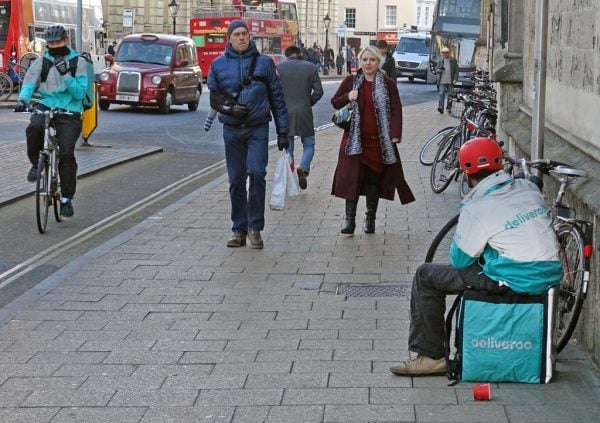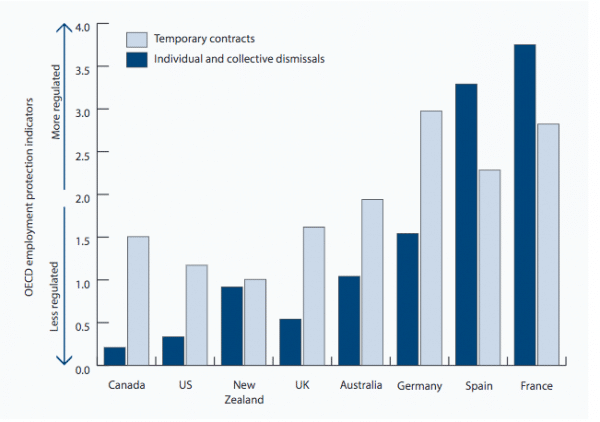The mobility of labour refers to how easily workers can move to different jobs within the economy. The two main factors of labour mobility are:
- Geographical mobility – how easy is it for a worker to move between different regions and countries to seek new work.
- Occupational mobility – how easy is it for a worker to move from one occupation to another.
We can also distinguish between an individual’s labour mobility and overall labour mobility for an economy.
- Personal labour mobility – each individual will have his own unique set of labour mobility. Some individuals may have very strong ties, which keep them looking after a relative in their home town. Other workers may have tremendous initiative and enthusiasm for learning new skills, which enables them to find work in emerging technologies. Young workers will tend to have greater mobility than older workers.
- National labour mobility. National labour mobility is an aggregate of all the individual labour mobility. It will be determined by factors, such as national education, skills and labour market regulations.

There are also different directions of labour mobility
- Horizontal labour mobility – this is a worker’s ability to move to another job at a similar pay grade, e.g. if you lose a job stacking shelves in Tesco, the worker gets a similar job at Sainsbury’s.
- Vertical labour mobility – this is the worker’s ability to move up and down the employment hierarchy. For example, can a worker on the minimum wage move up to positions of management? Discrimination may cause an invisible glass ceiling which may make it harder for minorities to get promoted.
Factors which determine mobility of labour
Geographical mobility
- Housing market. If rented accommodation is readily available and affordable, it will be much easier to move. One problem the UK faces is high living costs in London and the South East. A teacher in London may be discouraged from taking a job because of lack of affordable rented accommodation. Low affordability of housing can make labour markets less mobile.

- Transport. Transport is a factor which determines how easy it is to move around the country. Another issue is the availability of public transport for commuting purposes. Good rail links can make it easier for commuters to work in city centres with high housing costs.
- Immigration policy. Within the EU, free movement of labour enables workers to move to different countries in search of better job prospects. During the Irish construction boom, immigrant labour helped to fill labour shortages; as the construction sector went into decline, there was net outward migration.
Occupational mobility
- Skills / education. A key factor in determining occupational immobility is the relevant skills and education of workers which make it possible to move to different jobs. This is both standard educational qualifications, A-levels, degrees, but also more practical vocational qualifications, such as IT skills, qualified electrician.
General labour mobility
Other factors that influence general labour mobility.
- Minimum wage. A high national minimum wage may reduce the quantity of low paid jobs and reduce the number of part-time work. On the other hand, a national minimum wage can make work more attractive and encourage people to enter the labour force.
- Labour market regulations. Strict regulations on hiring and firing workers can reduce labour mobility. Workers may be tied to contracts, making it harder to change jobs. If firms face high costs of redundancy, they may have greater incentive to keep workers employed.
- Trades unions. Unions which operate closed shops or preferential contracts for insiders can make it difficult for workers to move into employment.
- Zero hour contracts create an incentive for workers to be more mobile. With an uncertain amount of work, they may need to juggle more than one job to earn sufficient income.
Importance of labour mobility
- Natural rate of unemployment. If labour is immobile, an economy is likely to face higher rates of structural unemployment. In a period of declining manufacturing employment, labour mobility is important for determining whether workers can relocate to newer jobs in the service sector.
- Rapid technological change Across the Western world we have seen a decline in manufacturing employment levels. This is due to rising labour productivity, and outsourcing of production to lower labour cost economies. Protecting these jobs from the onset of technological change is to fight a losing battle. The real solution is to improve the ability of workers to relocate and find new jobs in the service sector.
- Economic growth. High labour mobility may increase the productive capacity of the economy, it will be easier for firms expanding in new markets to attract qualified labour. Without labour mobility, innovation and expansion will meet supply constraints.
- Wages. High degrees of immobility may put upward pressure on wages in labour markets where there is a shortage of labour. This could even lead to a wage-price spiral. Greater mobility enables a more competitive labour market.
Issues with regard to labour mobility
- An economy which relies on high levels of labour mobility can make labour markets more stressful, with workers needing to rely on zero-hour contracts without any guarantee of sufficient work.
- Highly mobile labour markets may suit some workers who have the educational attainments and freedom to move around in search of work, but others may lose out because they struggle to cope with the pace of change.
- Downward vertical mobility. Another big issue is that the relative decline of manufacturing has caused workers to lose well-paid, permanent manual work. With low education levels, new employment opportunities tend to be of a different nature (temporary, no security) and therefore, the unemployed worker feels the labour mobility requires a decline in employment status.
- High levels of net migration can cause other social issues such as an impact on the limited housing stock.
International comparisons of labour mobility

Related

What is the impact of the mobility of labour on the labour market?
what are the pull and push factors which affect labour mobility
What is the relationship between mobility of labour and unemployment?
What are the ways in which government of a country can encourage mobility of labour?
what are the ways a government can encourage mobility of labour
*Government should take measures to increase bank lending
*They should invest in making housing more affordable
*Tax breaks on the use of new technoloi
*Markets should be deregulated
*Government should improve access to and quality of health care
using examples, how can labour be both immobile and mobile?
How do you distinguish/what are the differences between occupational mobility of labor and geographical mobility of labor?
what are the causes of mobility of labour